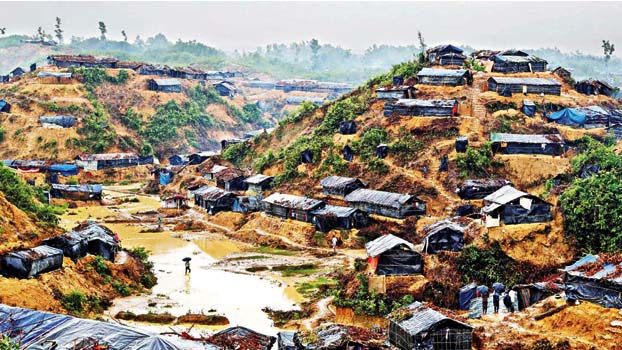Rohingya influx degrading our forest lands


A recent report of the Forest Department has revealed that the influx of the displaced Rohingyas has been causing extensive damage to forest resources of the Cox’s Bazar region. The speed and scale of the influx has resulted in a critical humanitarian emergency. The report reveals that Rohingyas have encroached on a total of 6200 acres of forestland in the Cox’s Bazar region while the forest land-grabbing spree is increasing every day. Thus the critical biodiversity areas in Cox’s Bazar are facing grave risks of peril due to high level of human interventions following the Rohingya influx.
Bangladesh is now hosting over 1.1 million forcefully displaced Rohingyas staying in 34 refugee camps in Cox’s Bazar district. The majority clusters in the forests around Kutupalong, which has become one of the world’s largest refugee camps. Once an area of thick greenery, Kutupalong has become a sea of plastic tents propped up against each other. Moreover, expansion of the old Kutupalong camp has blocked the only corridor used by the globally endangered Asian elephant as a migration route and trapped about 45 elephants in the western side of the camp. It also amplified human-elephant conflict, with 13 human casualties so far in the area. The remaining elephant habitat is under severe pressure from uncontrolled firewood collection in the forest, the article added.
Rohingya refugees, who have been arriving since late August, have also cleared about 2,000 acres of forestland in Ukhiya and Teknaf upazilas of Cox's Bazar. There is now not a single tree to be seen on the Ukhiya hills, which was once covered by dense forest inhabited by elephants and other wild animals. Soil erosion and landslides are already common in the area, affecting water resources, irrigation, and groundwater reserves. But now, local biodiversity, including marine resources, acoustic environment, and air quality, is being degraded at an unprecedented rate.
Ukhiya used to have species such as Dhakijam (Syzqium grande), Chapalish (Artocar), Gorjon, Gamari, and other trees not commonly found in other parts of Bangladesh. There is not a single tree left in the entire area. Hapless Rohingyas have even extracted the roots of the trees to use those as fuel. Setting up the refugee camp here has destroyed the whole forest land. Over the last one and a half years, tens of thousands of trees, both big and small, have been cut down to set up camps, make furniture and cook food, researchers have found. The financial cost of this destruction of forest in Ukhia and Teknaf upazilas stands at about Tk 1,865 crore, but the long-term consequences are more environmental than financial,
Experts are of the opinion that different types of relief materials are being distributed among the displaced Rohingyas but they are not provided with firewood for cooking purposes. As a result, the refugees are cutting down trees indiscriminately from nearby government forests and even uprooting the roots in their desperate search for firewood. What is more alarming is that some government, private and international donor agencies are engaged in cutting hills to build permanent structures for offices and quarters, thereby further threatening local forests and environment.
It is envisaged that the forest lands of Teknaf and Ukhiya will no longer exist if the depletion of forest resources continues unabated. According to a rough estimate, the Rohingyas are destroying forest resources to meet their daily demand of firewood of 2250 tons. Considering this the government should look for alternative options like LPG or low-cost coal for the displaced Rohingyas.
Taking the environmental degradation into consideration, reforestation at Cox’s Bazar Forest Division for compensation of lost forest areas in the area would be pertinent. Steps have been taken in this regard. But what is further needed is to identify and work with potential development partners to gain synergy on pipeline forestation projects.
Significant adverse impacts on various environmental components have been caused both by the Rohingya camps and by increased anthropogenic pressure far beyond the boundaries of the area of the camps. If the environmental impacts of the influx continue unmitigated, the already heavily polluted environment will soon suffer significant conversion and degradation, substantially reducing the habitat’s ability to maintain viable populations of its native species and losing its ability to sustain its ecosystem.
Prudent environmental management and detailed long-term monitoring programmes are recommended to mitigate the environmental damage and loss from the influx. The situation demands immediate investments in restoring the environment and ecosystem as part of the government’s humanitarian response in Cox’s Bazaar. Also there is a need to implement various mitigation programmes and offsets to prevent the environment from further degradation.
Sayeed Hossain Shuvro is Editorial Assistant, Bangladesh Post.



